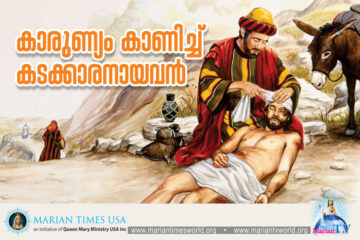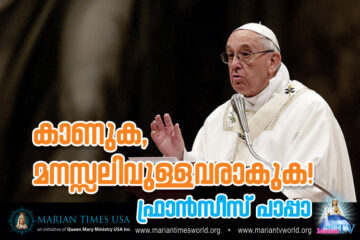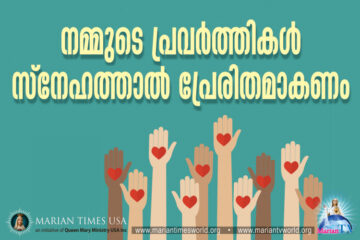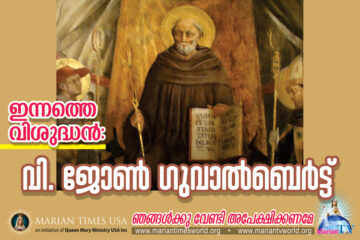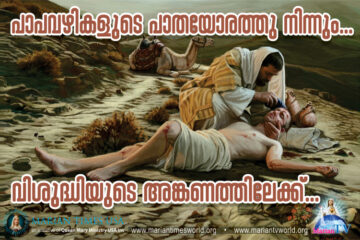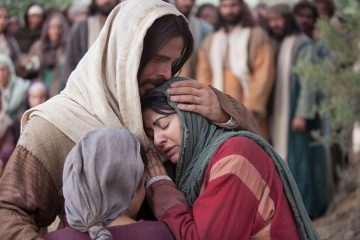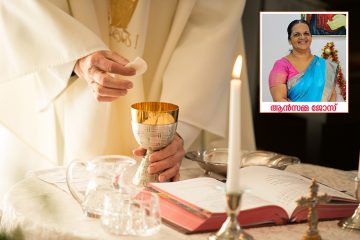Washing of the feet and Institution of the Holy Mass – Maundy Thursday Homily
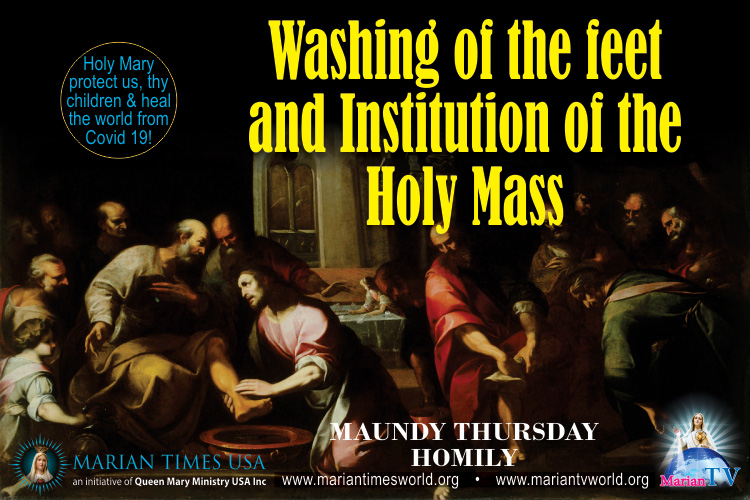
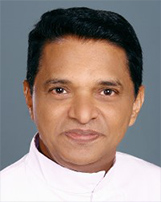
~ Fr. Abraham Mutholath ~
Chicago, USA. ~
INTRODUCTION
On Holy Thursday we celebrate with Jesus the Passover of the old and the new. The old Passover was the remembrance of the liberation of Israelites from the slavery of Egyptians through the blood of the innocent and unblemished lambs. In the new Passover, we celebrate the salvation of all humanity from the slavery of Satan through the blood of the perfect Lamb of God, Jesus. While remembering the old covenant God made with the Israelites through the sprinkling of animal blood on the people by Moses, we renew the new covenant God made by drinking the precious blood of Jesus shed for our sins. In preparation for this, we take part in the washing of apostles’ feet by Jesus as a pledge of our humble service and cleanliness of our souls.
Bible Text:
The Washing of the Disciples’ Feet. (John 13:1-14)
(1) Before the feast of Passover, Jesus knew that his hour had come to pass from this world to the Father. He loved his own in the world and he loved them to the end. (2) The devil had already induced Judas, son of Simon the Iscariot, to hand him over. So, during supper, (3) fully aware that the Father had put everything into his power and that he had come from God and was returning to God, (4) he rose from supper and took off his outer garments. He took a towel and tied it around his waist. (5) Then he poured water into a basin and began to wash the disciples’ feet and dry them with the towel around his waist. (6) He came to Simon Peter, who said to him, “Master, are you going to wash my feet?” (7) Jesus answered and said to him, “What I am doing, you do not understand now, but you will understand later.” (8) Peter said to him, “You will never wash my feet.” Jesus answered him, “Unless I wash you, you will have no inheritance with me.” (9) Simon Peter said to him, “Master, then not only my feet, but my hands and head as well.” (10) Jesus said to him, “Whoever has bathed has no need except to have his feet washed, for he is clean all over; so you are clean, but not all.” (11) For he knew who would betray him; for this reason, he said, “Not all of you are clean.” (12) So when he had washed their feet [and] put his garments back on and reclined at table again, he said to them, “Do you realize what I have done for you? (13) You call me ‘teacher’ and ‘master,’ and rightly so, for indeed I am. (14) If I, therefore, the master and teacher, have washed your feet, you ought to wash one another’s feet.
The Lord’s Supper.
(26) While they were eating, Jesus took bread, said the blessing, broke it, and giving it to his disciples said, “Take and eat; this is my body.” (27) Then he took a cup, gave thanks, and gave it to them, saying, “Drink from it, all of you, (28) l for this is my blood of the covenant, which will be shed on behalf of many for the forgiveness of sins. (29) I tell you, from now on I shall not drink this fruit of the vine until the day when I drink it with you new in the kingdom of my Father.” (30) Then, after singing a hymn, they went out to the Mount of Olives.
Interpretation
The Washing of the Disciples’ Feet.
(1) Before the feast of Passover, Jesus knew that his hour had come to pass from this world to the Father. He loved his own in the world and he loved them to the end.
Before the feast of Passover
The last supper of Jesus was a Jewish Passover Meal that was a remembrance of the deliverance of the Israelites from the slavery of Egyptians. It was also a recollection of slaying a lamb and marking the door posts of their houses with the blood of the lamb so their first-born children were savedfrom the final plague of death. Jesus was getting ready to replace the blood of the lamb with his own blood and mark it on the cross instead of the door posts so that his first-born children in faith would be saved from the eternal death.
Jesus knew that his hour had come
We oftentimes hear in the gospel that the hour of Jesus had not yet come. The evangelist gives the meaning of the hour of Jesus stating that it was the time, “to pass from this world to the Father” by fulfilling his mission through his passion, death, and resurrection.
To pass from this world to the Father
Death for Jesus and his followers have been a passage from this world to God the Father. Like the passage from the slavery of Egyptians to the promised land, we also pass from this world of slavery of sin to the freedom in the promised land of heaven.
He loved his own in the world
Jesus’ own were those he called and who left everything and followed him. They were like his family. Jesus was the head of the family and the apostles were his “little children” (John 13:33). It was time for him to depart from this world to his Father. However, he promised them that he would not leave them as orphans (John 14:18). This description gives the mood of how Jesus and his apostles felt at the time of their farewell and how much Jesus loved and cared for them. John the Evangelist who documented this was an eye-witness to this event along with other apostles.
He loved them to the end
Jesus loved his own to the end of his life and affirmed it by offering his life for their salvation. His love would continue from heaven by supporting them in their mission till the end of their lives in this world. We notice Jesus’ love to the end of his life on the cross by entrusting Mary and John to each other, by promising paradise to the repentant criminal who was crucified with him, and even forgiving and praying for those who persecuted him. He continued his love by appearing to his loved ones after his resurrection and sending the Holy Spirit upon the apostles on the day of Pentecost.
(2) The devil had already induced Judas, son of Simon the Iscariot, to hand him over. So, during supper,
The Evangelist John adds here the intention of Judas to betray Jesus for money under the influence of devil. By this, John reveals what was going on in the minds of Jesus and Judas in that gloomy context of farewell Passover. The contrast in the mental status of Jesus and Judas that no one else knew gives the readers a dramatic mood of the situation.
(3) Fully aware that the Father had put everything into his power and that he had come from God and was returning to God,
This verse of the power of Jesus that he inherited from his Father, sets the background for the humble act of washing the feet of the apostles. Before returning to his Father, Jesus desired to demonstrate a memorable message to his apostles who had been competing for noble positions in this world.
(4) He rose from supper and took off his outer garments. He took a towel and tied it around his waist.
He rose from supper and …
People in the past were walking on dirty or dusty roads with sandals on their feet. They used to eat the meal in a reclining position so that the feet might be on the sofa instead of on the floor and close to the face of person reclining nearby. So, it was important that they had to wash their feet before entering a house. Usually a slave, servant, or host (Luke 7:44) would wash the feet ofthe guest. This might have been missed when Jesus and the apostles gathered for the Passover because they had no host or servant. None of the apostles wanted to be at the service of others, not even to wash the feet of their Lord. So, they might have started the supper without the ceremonialwashing of feet. Jesus might have noticed it and decided to teach them a lesson by making himself a humble servant of his disciples. According to the Jewish practice, the washing the feet had to be done before the Passover celebration and not during the supper.
Took off his outer garments. He took a towel and tied it around his waist.
Jesus took off his outer garment and tied a towel around his waist which was the dress of a servant. It was an amazing experience for the apostles to see their master dressed for service. They had no idea what he was going to do. Prophets often used symbolic and dramatic actions to convey strong and memorable messages to the people. Jesus was using the same methodology. He was fulfilling what he had said earlier. “I am among you as the one who serves.” (Luke 22:27).“The Son of Man did not come to be served but to serve and to give his life as a ransom for many.” (Matthew 20:28). The incarnate God was doing the menial job of a slave for his subjects.
(5) Then he poured water into a basin and began to wash the disciples’ feet and dry them with the towel around his waist.
Towel, wash basin, and jug of water were customarily placed inside the house for repeated washing of hands in between different courses of food during the meal. Jesus used them for the washing of the feet. Jesus did not seek the help of anyone to pour water in the basin. He did everything himself like a humble slave. According to the custom of the time, if there was no slave or servant, an inferior would wash the feet of a superior like wife to her husband and children that of parents; but not vice versa. Disciples were obliged to wash the feet of their master. However, the master was not supposed to serve his disciples. By doing this act, Jesus was touching the hearts and minds of his disciples. Besides washing the feet, Jesus was carefully and affectionately wiping the feet clean with the towel girded around his waist.
(6) He came to Simon Peter, who said to him, “Master, are you going to wash my feet?”
He came to Simon Peter
Scholars differ on whose feet Jesus washed first. Some are of opinion that he washed the feet of Judas first; while others say he washed the feet of Simon Peter first.
Master, are you going to wash my feet?”
Peter was an outspoken person. His questioning of washing his feet by the master was a natural reaction from his humility and respect for the master.
(7) Jesus answered and said to him, “What I am doing, you do not understand now, but you will understand later.”
Jesus later clarified the meaning of what he did in John 13:13-17. “If I, therefore, the master and teacher, have washed your feet, you ought to wash one another’s feet.” (John 13:14).
(8) Peter said to him, “You will never wash my feet.” Jesus answered him, “Unless I wash you, you will have no inheritance with me.”
“You will never wash my feet.”
Instead of accepting Jesus’ clarification and promise of understanding of the act later, Peter strongly objected to washing his feet out of his reverence to Jesus. Apostles had no idea what Jesus was doing and what he was going to do. In Jesus’ mind, he was preparing his disciples to receive the Holy Eucharist that he was going to establish immediately after the washing of the feet. This act of washing gave them warning that they should humble themselves to serve and purify themselves to administer and to receive the Holy Eucharist that they would continue in their lives.
Unless I wash you,
Oftentimes when Jesus had a discussion, he would switch from a material sense to a spiritual level of understanding as in the case of his discussion with Nicodemus (John 3:1-21) and Samaritan woman (John 4:4-42). In this discussion with Peter, Jesus advanced his reference to the washing dirt of the feet with water, to washing the sins of Peter with his precious blood and Holy Spirit. Jesus is not limiting the washing to Peter’s feet but his whole person because he was saying “I wash you.”
You will have no inheritance with me
Jesus was going to inherit the Kingdom of God after his passion, death, and resurrection. Jesus presented this washing of Peter with the blood and Holy Spirit as a requirement for Peter to inherit with Jesus the Kingdom of God in heaven. By addressing this to Peter, Jesus offered all his disciples a partnership with him in the Kingdom he would inherit from his Father. For that, we also need to wash away our sins in the blood of Jesus and receive his Holy Spirit. Only those who are washed by Christ will have a part in the church he established here in this world and will inherit the Kingdom of God with Jesus in heaven after death.
(9) Simon Peter said to him, “Master, then not only my feet, but my hands and head as well.”
Just as it happened in the discourse of Jesus with Nicodemus and Samaritan woman, Peter also did not comprehend what Jesus meant. He continued taking the washing in the literal sense. So, out of enthusiasm, he asks the Lord to wash his hands and head, the uncovered parts of his body. He was ready to offer anything to inherit the Kingdom of God with Jesus. So, he was requesting Jesus to cleanse all actions of his hands and all the thoughts of his head.
(10) Jesus said to him, “Whoever has bathed has no need except to have his feet washed, for he is clean all over; so you are clean, but not all.”
Whoever has bathed has no need except to have his feet washed, for he is clean all over.
Here also, Jesus has a physical and spiritual sense in the statement. Those who came after a bath of the whole body, needs only washing the dust or dirt of the feet that he got by walking on the road. In the spiritual sense, those who are baptized in the blood of Jesus and his Holy Spirit need only a cleansing like the Sacrament of Reconciliation or an act of contrition. Only after that he shall partake in the Holy Eucharist which is a foretaste of the eternal banquet in heaven.
You are clean, but not all
Jesus here revealed an exception, though only he knew who the person was. Judas was bathed in the baptism of Jesus and thus made clean all over. However, the devil entered his heart and polluted it to love money more than the master and to betray his master for money.
(11) For he knew who would betray him; for this reason, he said, “Not all of you are clean.”
Jesus knew what was in the mind of Judas while he was taking part in the Last Supper and in the washing of the feet. Jesus was polite not to identify that it was Judas who was going to betray him. Judas was hearing the words of Jesus as a warning to him. However, he was so attached to wealth that he could not resist the temptation and accept the discourse of Jesus. Those who are under the devil’s possession will not be willing to open their minds to the Word of God. Those who are enslaved by bad addiction would normally avoid any spiritual warning.
(12) So when he had washed their feet [and] put his garments back on and reclined at table again, he said to them, “Do you realize what I have done for you?
Reclined at table again
After the washing of the feet, Jesus took the position back as the master to instruct them and to share the meal with them. People ate meals in a reclining position during those days. The original Passover in Egypt was done in a standing position. Later it was done on reclining position to show their relaxation and freedom because of their redemption from slavery.
“Do you realize what I have done for you?
Jesus raised this question not expecting an answer from the apostles but to get their attention for his interpretation.
(13) You call me ‘teacher’ and ‘master,’ and rightly so, for indeed I am.
Students were not used to call their teacher by name among the Jews. So, they called “teacher,” “master” or “Lord” with respect.
(14) If I, therefore, the master and teacher, have washed your feet, you ought to wash one another’s feet.
Jesus, who washed the feet of the disciples like a slave, also emphasized his higher position above them by repeating and reversing the words “master and teacher” to magnify their role to be servants to one another regardless of their position in the community. It is not a suggestion but a commandment is clear from the term “you ought to.” Jesus had demonstrated his law of humility and service in action.
The Lord’s Supper. (Matthew 26:26-30)
The Last Supper of Jesus is to be understood in the background of the Jewish Passover because the last supper of Jesus and his institution of the Holy Eucharist (Qurbana) took place while Our Lord was celebrating the Passover with his disciples in an upper room in Jerusalem. Passover, one of the three pilgrim feasts was to be celebrated in Jerusalem (Leviticus 23: 4-14, Deuteronomy 16:1-8). A lamb was sacrificed in the Temple and its meat was taken home and ate during the Passover meal. The procedure for the Paschal feast has been known as the Seder which means “order” that give 15 stepsofprocedure and prayers in a book known as Haggadah.The fifteen corresponds to the 15th day of Nissan when Passover starts or the 15 semi-circular steps from the Court of Women to the Court of Israel in the Temple. Levites sang the fifteen “Psalms of the Steps” (Psalms 120-134 of Degrees or Ascents) with musical instruments there.
The proceduresfor Passover meal,along with how Jesus observed it, are given below:
PREPARATIONS FOR PASSOVER
- Selection of the lamb on the 10th of Nisan. Family would select a one-year-old unblemished male lamb for sacrifice. In Jesus’ case, he was the unblemished and male lamb,selected and brought to the Temple by the family of Israel and approved by the priests for slaughter. This had happened on the Palm Sunday that was the 10th ofNisan. The slaughter of the lambs would take place between the evenings of 14th and 15th of Nisan. Jesus instituted the Holy Eucharist on 14th evening and was crucified on Friday the 15th.
- Searching Leaven on 13th of Nisan. Any leaven in the house had to be checked and removed based on God’s commandment: “No leaven is to be found with you in all your territory for seven days.” (Deut. 16:4). Jesus did this on the Palm Sunday by cleaning the Temple and removing all the merchants who were making the temple defiled.
- Foot washing on 14th of Nisan. When the guests and family members arrived at the house for the Passover meal, a slave or servant would wash their feet. Since his disciples did not perform this, Jesus did this for them during the meal which was unusual. It was to teach them how they should be following his servant leadership in their ministry.
- Table setting:Charoseth (a sweet dark-colored paste made of fruits and nuts), unleavened bread, vegetables, vinegar (karpas), four wine glasses, red and warm wine bottles, and several candles were set on the table. The people would be sitting in a reclined position with support of pillows around a low table about 18” high. Seating was arranged according to age or social position of the participants.
THE 15 STEPS OF PASSOVER MEAL
Step 1. Kadeish(Sanctification): The head of the family who sat at the place of honor would take the first out of the four wine cups and fill it with wine mixed with water (grape juice for children) and pronounced a thanksgiving over it. He would taste it first and then pass it to all present. The four cups of wine stood for the four “I wills” in Exodus 6:6-7. “I will free you from the burdens of the Egyptians (The Cup of Sanctification) and will deliver you from their slavery (The Cup of Deliverance). I will redeem you by my outstretched arm and with mighty acts of judgment (The Cup of Redemption). I will take you as my own people, and I will be your God (The Cup of Restoration) and you will know that I, the LORD, am your God who has freed you from the burdens of the Egyptians.” (Exodus 6:6-7).
Step 2. Urchatz (Washing of Hands): Participants washed their hands by pouring water on the right hand three times, and then left had three times in preparation for eating the herbs dipped in salt water.
Step 3. Karpas orBitter Herbs (usually parsley) was eaten after dipping it in salt water. The vegetable was symbolic of the poor background of the Jewish people and the salt water was symbolic of the tears shed by the Israelites in Egypt during slavery and throughout their history.The salt water also reminded them the Red Sea they crossed with the providence of God while leaving Egypt. The second cup was then poured with wine.
Step 4. Yachatz (Breaking of middle matzo bread): Three matzobreadswere placed in three pockets of matzo cover. Matzo bread was an unleavened flat bread with stripes and piercings on it symbolic of the scourging and nailing of the Messiah according to Christian interpretation. These three breads, according to Christian interpretation, represented the Most Holy Trinity. The middle one representing Messiah, the second person of the Trinity, was broken into two pieces reminding of the broken body of Christ for our sins. The smaller piecerepresenting the “bread of affliction” was returned to the pocket and the larger one representing Pesach Sacrifice was kept in a hidden place in another cover. For Christians, this represented the burial of Jesus.
Step 5. Magid(Story telling) of Exodus from Egypt as a question-answer session:The youngest son or the least significant person would be asking four questions on the difference of that night from the banquet of other nights. The head of the family would give the answers and clarify the significance of the special food items.Participants then drank the second cup of wine.The first half of the Hallel Psalms 113-114 were recited then.
Step 6. Rachtzah (Second hand-washing)by the participants with a blessing in preparation for eating the matzah, the unleavened bread: Paschal Lamb, charoseth (paste of nuts and fruits) with vegetables, and two of the unleavened bread wafers were served.
Step 7. Motzi(The blessing for bread) holding the remaining matzah bread.
Step 8. Matzah (Unleavened Bread):Everyone ate a part of the top and the middle matzah. They lean to the left when they eat.
Step 9. Maror (Bitter Herbs): Eating of bitter vegetable like raw horseradish or romaine lettuce after a blessing was recited over it. Bitter Herbs reminded the bitterness of slavery. The bitter herb was dipped in charoset, a sweet dark-colored paste made mixing apples, nuts, cinnamon and wine, that signified the mortar used by the Israelites for construction work in Egypt during their slavery.
Step 10. Koresh (Matzah Sandwich): Filled two pieces of Matzah with Maror and Romaine lettuce, made a special prayer and ate it while leaning to the left.
Step 11. Shulchan Orech (Dinner):The Pascal lamb was cut into pieces and each received a portion with unleavened bread and bitter herbs dipped in sauce.
Step 12. Tzafun/ Afikoman(Half-piece Matzo bread):Children were asked to find the piece of matzah bread that was hidden earlier. The finding of it represented the resurrection of Jesus according to Christian view. That was broken into pieces and shared by all saying, “This is the bread of affliction that our fathers ate in Egypt”. At this point Jesus established the Holy Eucharist using probably the Afikoman bread. “Jesus took bread, said the blessing, broke it, and giving it to his disciples said, ‘Take and eat; this is my body.’” (Matthew 26:26).
Step 13. Barech (The Cup of Redemption): The third cup of wine was poured; a blessing was said over the cup and all the participants sharedit. This was the time when Jesus instituted the second part of the Holy Eucharist. “Then he took a cup, gave thanks, and gave it to them, saying, “Drink from it, all of you, for this is my blood of the covenant, which will be shed on behalf of many for the forgiveness of sins.” (Matthew 26:27-28). Jesus and his apostles left the room to the Garden of Gethsemane at this point and the rest of the Passover continued through his sacrifice as the Lamb of God on the Cross.
Wine was poured on the fourth cup as well as an additional cup set aside for the prophet Elijah, who was supposed to announce the arrival of Messiah on a Pesach day. A door was then opened to invite Elijah into the house.
Step 14. Hallel (Praises): The rest of the psalms (Hallel) were recited (Psalms 115-118) followed by a blessing over the forth cup of wine and it was drunk. Jesus considered fourth cup as his suffering, he prayed at the Garden of Gethsemane, “Father, if you are willing, take this cup from me; yet not my will, but yours be done.” (Luke 22:42).
Step 15. Nirtzah(Closing): The Passover concluded saying “It is finished” and with the prayer, “Next Year in Jerusalem” hoping that they might celebrate Pesach the following year in Jerusalemwith the arrival of the Messiah.Jesus also said, “It is finished” after tasting the fourth cup on the cross just before his death.
(26) While they were eating, Jesus took bread, said the blessing, broke it, and giving it to his disciples said, “Take and eat; this is my body.”
While they were eating, Jesus took bread
While Jesus and his apostles were eating the Paschal meal and before the third cup of wine was drunk, Jesus took the bread. This was specially cooked unleavened bread that was symbolic of sinlessness.
The bread and wine were the offering of Melchizedek, the priest of Salem which was later known as Jerusalem (Genesis 14:18). Jesus later became the high priest after the order of Melchizedek. (Psalm 110:4). Jesus revived the offering of Melchizedek and replaced the animal sacrifice in the Temple with the Holy Eucharist.
Said the blessing, broke it, and giving it to his disciples
Jesus said blessing over the unleavened bread to transubstantiate it to his body. Breaking the bread was symbolic of the sufferings underwent by the Israelites in the past. When Jesus instituted the Holy Eucharist, it became representative of his passion and death. After breaking the bread, Jesus passed the pieces to his apostles.
“Take and eat; this is my body.”
Jesus calls the bread his body, and not as a symbol of his body. Jesus fulfilled his promise, “I am the bread of life. Your ancestors ate the manna in the desert, but they died; this is the bread that comes down from heaven so that one may eat it and not die. I am the living bread that came down from heaven; whoever eats this bread will live forever; and the bread that I will give is my flesh for the life of the world.” (John 6:48-51).
(27) Then he took a cup, gave thanks, and gave it to them, saying, “Drink from it, all of you,
He took a cup
Jesus took the third cup known as “The cup of Redemption.” This cup had wine mixed with little water called “the cup of blessing” (1 Cor. 10:16) because of a special blessing said over it thanking God for the wine and food they could produce by the grace of God. It was the principal cup and was done after the Pascal meal. It was red representing the blood marked on the door posts of the Israelites, when the angel of death passed over their houses. Similarly, the blood of Christ was for the saving of people.
Drink from it, all of you
Jesus asked his apostles to drink his “blood” of the new covenant. Jews were not allowed to drink any blood because it represented the life of the person or animal. Unlike Moses sprinkling the people with the animal blood (Exodus 24:6), Jesus was giving his own sacramental blood for his believers to drink because his covenant was not external but internal. When a believer drinks the sacramental blood of Jesus, he is receiving the life of Jesus and becomes in communion with his life.
(28) For this is my blood of the covenant, which will be shed on behalf of many for the forgiveness of sins.
Blood of the covenant
Jesus here used the same phrase used for the Old Covenant that God made with Israelites through Moses at Mount Sinai as given in Exodus 24:3-8. People agreed to all the ordinances of the Lord when Moses came down from the mountain and related it to them. Moses then built an altar at the foot of the mountain. The Israelites offered burnt offerings of young bulls. Moses took half of the blood in large bowls and the other half he splashed on the altar. Moses read aloud from the book of the covenant to the people who responded, “All that the LORD has said, we will hear and do.” Moses splashed the blood on the people, saying, “This is the blood of the covenant which the LORD has made with you according to all these words.”
Just as Moses was the mediator of the old covenant, Jesus became the mediator of the New Covenant established at the last supper and fulfilled on Calvary. After using wine for his blood, Jesus shed his blood for humanity through the torture and crucifixion he underwent.This was the fulfillment of the new covenant prophesied by Prophet Jeremiah in 31:31-33.
Which will be shed
The bloodshed of Jesus as the perfect paschal lamb was going to happen within hours after the blessing of the cup. Lambs were to die to save the first born of the Israelites in Egypt. Jesus had to die to save all humanity from spiritual death.
On behalf of many
Sacrifice of Jesus’ life was for the salvation of all. So, all are eligible for redemption. However, each one has the freedom to accept or reject it. “Many” will accept and benefit from it.
For the forgiveness of sins.
The bloodshed of Jesus was for the forgiveness of sins of all. The animal sacrifices of the past were for ritual and ceremonial purification that could not take away the sins of humanity, especially the original sin inherited from the first parents. The divine sacrifice of Jesus in his human suffering replaced them all because it was the perfect sacrifice that could take away the sins of humanity.
(29) I tell you, from now on I shall not drink this fruit of the vine until the day when I drink it with you new in the kingdom of my Father.”
In the kingdom of my Father
The Kingdom of the Father is distinct from the kingdom of the Messiah or the son. The Kingdom of Messiah had started with the incarnation of Jesus, continued through this resurrection, ascension, descent of the Holy Spirit, the second coming of Christ and until all the saved will be presented by Jesus to his Father. Then only the Kingdom of the Father will take place. Christ will drink the new spiritual wine, the best wine reserved for the last (as in the wedding of Cana), in the kingdom of heaven. That is the time when “many will come from the east and the west, and will recline with Abraham, Isaac, and Jacob at the banquet in the kingdom of heaven.” (Matthew 8:11). Wine and banquet are representation of the spiritual joy in heaven.(30) Then, after singing a hymn, they went out to the Mount of Olives.
After singing a hymn
Jesus skipped the forth cup of the Passover so he could complete it at the crucifixion. After the second part of the songs of praise called “Hallell,” he left to offer his life as the sacrificial lamb.When Jesus was near death on the cross, “aware that everything was now finished, in order that the scripture might be fulfilled, Jesus said, ‘I thirst.’ There was a vessel filled with common wine. So they put a sponge soaked in wine on a sprig of hyssop and put it up to his mouth. When Jesus had taken the wine, he said, ‘It is finished.’ And bowing his head, he handed over the spirit.” (John 19:28-30). When Jesus spoke “It is finished,” he was not referring to the completion of his life or mission but to the 15th step of the Passovercelebration. Thus, on the cross, Jesus finished his Passover mealdrinking the fourth cup and declaring the end of the Passover celebration.
They went out to the Mount of Olives
The Mount of Olives was on the east side of Jerusalem where Jesus used to go for prayer. Jesus knew that Judas would lead the Jewish leaders and soldiers there to arrest him because the disciples knew his place of night prayer when he was in Jerusalem.
Message:
- Jesus even washed the feet of Judas whom he knew was going to betray him for money. Jesus who taught us to love our enemies and bless them, had shown that in action by washing the feet of Judas. Let us follow Jesus’ model of being tolerant to those who plot against us.
- Jesus washed the feet of his disciples just before establishing and sharing the Holy Eucharist. This reminds us the relationship between the sacraments of confession and Holy Communion. Before participating and receiving the Holy Eucharist (Qurbana), we need to purify ourselves by cleansing our soul by confession or by an act of contrition. The penitential service during the Holy Mass (Qurbana) before the reception of Holy Communion shall be made with more attention.
- Judas, along with other apostles, had received the baptism, washing of feet, Holy Eucharist and even ordination of Jesus. However, he failed not because of the failure of anything offered by Jesus but by his shift of interest in worldly wealth that Jesus had warned to avoid for heavenly treasure. Judas even ignored the warnings Jesus gave at the last supper. Satan is after the holy people with offers of worldly riches or glory. They will have the tendency to resist the Word of God or to avoid listening to it if they are possessed by the worldly desires.
- Passover was a feast of unleavened bread. Leaven was symbolic of sin and it had to be scrupulously removed. Our mothers used new utensils and vessels to prepare Passover food in remembrance of this. This also reminds us of our need for spiritual cleanliness especially during the Holy Week.
- On the real Passover in Egypt, only those who obeyed the commandment of God through Moses to sacrifice the lamb and mark the doorposts of their houses with the blood of the lamb were saved from the slaying of the first-born sons. The fact that they were Israelites could not save them from the final plague in Egypt. Though salvific sacrifice of Jesus was for all, only those who follow the teachings will be saved.
മരിയന് ടൈംസിലെ ഇന്നത്തെ പ്രധാനപ്പെട്ട അപ്ഡേറ്റുകള് താഴെ ലഭിക്കുന്നതാണ്.


